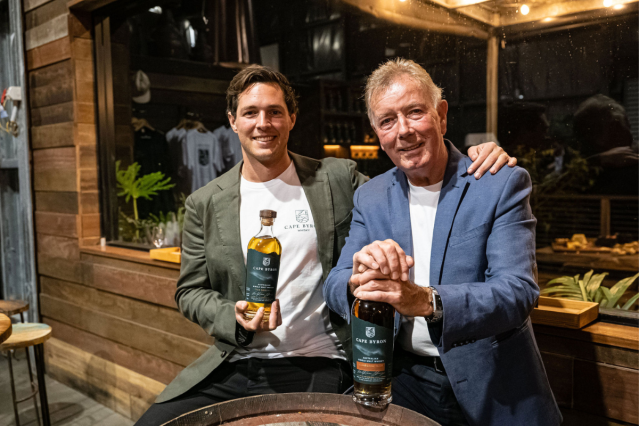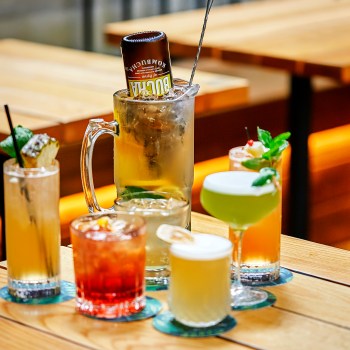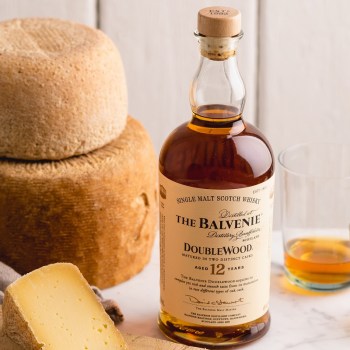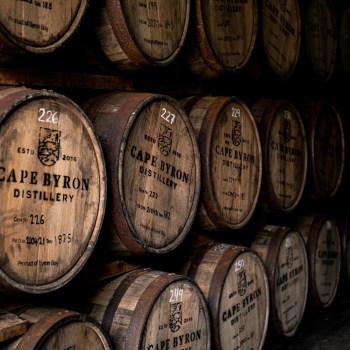Last Thursday, 1 September, the great and good of Sydney’s drinks industry gathered at the Oak Barrel to celebrate the release of Cape Byron Distillery’s first whisky.
At the event, members of the hospitality and retail sectors tasted the distillery’s flagship ‘Original’ bottling, alongside a Chardonnay cask finish, and a taste of peated malt spirit (not yet old enough to be called whisky). A barrel aged version of the distillery’s Mac. Liqueur was also served.
Hosts for the day were Cape Byron Founder Eddie Brook and legendary Scottish distiller, Jim McEwan, who explained how they first met, and how they worked together to produce both Brookies Gin, and now Cape Byron whisky.
After the launch, Bars and Clubs sat down with both Eddie and Jim to learn more about the creation of this whisky, the impact of Cape Byron’s unique climate, and how the distillery’s commitment to sustainability has informed its approach.

A Cape Byron house-style
With so many new Australian whiskies on the market these days, having a clearly distinguishable house-style and brand narrative is vital for success. Luckily for Eddie, he had a resource available to no other Australian distiller: the wealth of knowledge possessed by Jim McEwan.
Jim has more than 50 years’ experience in the whisky business, having worked at Bowmore for 38 years, before overseeing the rebirth of Bruichladdich and most recently helping to get new Islay distillery, Ardnahoe, off the ground.
Eddie says that whisky is “a lifeblood of Scotland,” and recognised the advantage he had in working alongside Jim.
“I’m extremely so fortunate,” Eddie continues.
“I want to make sure that the whisky we’re doing pays homage to those traditions, and we want to make sure that we’re doing all those elements correctly.”
Jim concurs, explaining what the core elements required for any good single malt are “good slow distillation, quality malted barley, good casks, time.”
With this in mind, Eddie says, the distillery’s flagship bottling was designed to capture something of that Scottish style.
“The Original is a real traditional style of single malt whisky – it’s a classic, that’s why we call it the original. However, it’s not Scotland, it’s not Islay – it’s us, it’s our DNA,” Eddie says.
“That’s the thing for us – the spirit, that’s what is exceptional. It’s so clean, it’s got this beautiful fruity character to it, it’s elegant.”
The whisky has also been aged in the traditional vessel for single malt whisky: American oak Bourbon casks.
“They go together like a match made in heaven. [The whisky is] not overly dominated by the oak, it’s letting the spirit sing, and we’re seeing this marriage,” Eddie says.
Of course, with the pressure to get to market, alongside the warmer climates of Cape Byron, it would be tempting to use smaller barrels to supercharge the spirit with oak, and ‘accelerate’ the ageing process. This is not the path that Cape Byron has taken, however, as Eddie explains.
“In Australia, we’ve got this climate that gives us faster maturation. Now that’s great, but it can also get too much, you can get too much tannin and then over-oaking in your whisky,” Eddie explains.
To avoid this, Eddie says, Cape Byron only matures in full format barrels, between 200 to 300 litres in size, and has constructed specialised maturation facilities to offset Byron’s temperature extremes.
“Our warehouse is on a hill, and we’ve cut into the earth, and our barrels are resting in those warehouses,” Eddie says.
Eddie’s parents, Pamela and Martin, painstakingly restored the rainforest at the site which is now home to Cape Byron Distillery. This reforestation has had added benefits for whisky maturation, as Eddie illustrates.
“We created this environment, and what the rainforest gives us is like a thermal cooling effect. It’s like nature’s air conditioning. The environment gives us this great maturation piece.”
The location has also influenced the character of the final whisky, as Eddie outlines.
“In Byron Bay we talk about our location as where the rainforest meets the sea,” Eddie says.
“Walk down the barrel room – all the hoops [on the barrels] are rusted through. It’s laden with salt and you’re getting that marine character and influence coming through.”
Jim has also detected this quality in the Byron spirit.
“That moisture is falling on the oak staves, and slowly but surely, there’ll be a residue of salt and eventually as the whisky moves in and out, as the temperature increases, the alcohol will expand and it will touch the salt, and pull it back, and that brings a unique marine freshness to the spirit – quite different from anything else,” Jim comments.

A partnership across generations
Bars and Clubs asked the pair exactly how the partnership between them had worked – and what Jim’s role in the practical creation of the whisky was.
“I was trained and mentored by Jim – so bloody fortunate!” says Eddie.
Jim says that after meeting Eddie, he instantly saw his passion for whisky.
“We struck up this friendship, and I could tell immediately, he was really into it,” Jim explains.
“He liked the story behind it, and the differences – even if you take Scotland, even Islay, where I come from, you’ve got eight [now nine] distilleries from this tiny area, yet they’re all producing something completely different from each other – that’s the beauty of whisky.”
Despite a lifetime in the business, Jim appears genuinely enthused by the prospect of Cape Byron’s spirit.
“It’s been really very exciting for me to be assisting in [Eddie’s] desire to create the perfect Australian single malt, that’s as good as anything from Scotland,” Jim comments.
Eddie says that Jim helped him to ‘set’ the recipes of the whisky – the distilling practices and flavour profiles – beginning with the whisky’s wash, which is produced at nearby Stone & Wood brewery.
“We have the opportunity to use Australia’s best brewers to create the best wash and wort, then drive up the hill to ferment it. It’s a great partnership.
“We set the yeast structure and the malt build, and when we distil it. Then I train the team on to keep that consistent, and the barrel program we use. So Jim came over and he set the spirit again, and my role is to make sure our team is right,” Eddie adds.
The distillery has bet big on its future too, purchasing a new 4,500 litre still, which will bring production capacity to 350,000 litres a year.

Working hand in hand with Australian wine
At Bruichladdich, Jim was well known for using high quality wine casks in the maturation of single malt. Now with Cape Byron, Jim and Eddie have Australia’s world-class wine industry to draw upon as a source of barrels.
“It just blows your mind!” Jim exclaims.
“If you think of some of the great wines of Australia – you’re just thinking ‘that would go great with a single malt.’”
“That’s the lucky position we’re in. A single malt in Bourbon – that’s a stand-out, we know it’s a stand-out, but you can also have a great pleasure from a single malt from a great wine cask – it just changes the dynamic completely.”
Eddie agrees and believes that changes in the whisky market mean there is greater interest in different styles of single malt.
“The stereotypes are broken about what a whisky drinker is. We’re in this modern world now. If you like a good quality wine, or a craft beer, or maybe a sour or different varieties of gin. Come over and explore quality single malt whisky,” Eddie continues.
“That’s why I created the Chardonnay cask, to showcase the flavour of what a Chardonnay cask can bring – this luscious fortified character coming through.”
Smoke on the horizon
The choice to create a smoked spirit (made with peated barley shipped at great expense from Scotland) is certainly an interesting one, with this malt spirit rare among Australian distillate.
Cape Byron have certainly committed to this concept, with roughly 30 per cent of all spirit produced now in this smoky style. Bars and Clubs asked Eddie and Jim if they forecasted growth in this area of the domestic whisky market.
“Even five years ago the sales of Laphroaig, Lagavulin, Bowmore – they were good sales, but its certainly in the last five years… there’s been a total explosion in the love for Islay malt,” Jim says.
“The consumer loves a peated whisky, especially in Australia, we’ve got such an educated single malt whisky drinking nation here,” Eddie adds.
And there may be more to come in the future, with Cape Byron Distillery looking to use macadamia wood cleared from its farm to smoke malt for whisky.
Spirit of sustainability
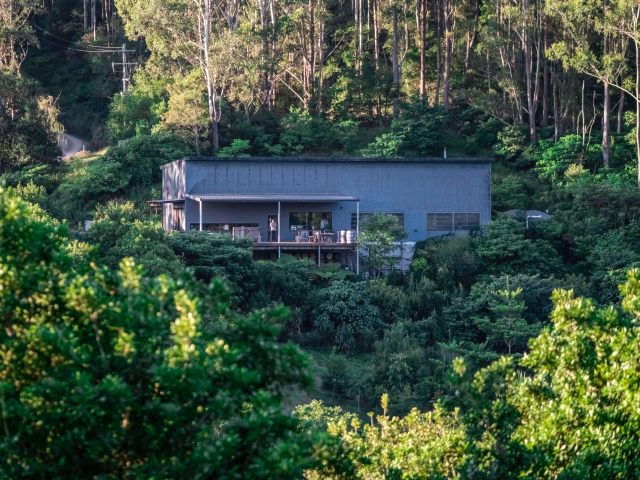
Cape Byron, which was recently certified as a B Corp, puts sustainability at the centre of its business model, as Eddie explains.
“We talk about sustainability and it’s at the roots of our family,” the distiller says.
“We’ve been caring for the regenerating rainforests, working to have a positive impact on the community and environment long before we started a business – that’s at the core of our values.
“Every single thing we do at Cape Byron Distillery is run through our sustainability filters.”
Eddie also points out that by working with Stone & Wood, they’re purchasing from another B Corp certified business. In practical terms, the distillery also reuses the spent grain and mash (called “pot ale” in distilling) on their Davidson plum and macadamia farms.
Alongside the new still, Eddie has overseen the installation of a BioGill system, so that as volumes are increasing, wastewater can be treated for irrigation purposes.
Sustainability also extends to the distillery’s business practices, with the distillery providing about 35 jobs in the Byron Bay hinterland. And Eddie certainly has a long-term horizon.
“Exit strategy is generation. We don’t use that term lightly – generational. We are 100 per cent family and 100 per cent McEwan and Brook’s ownership to pass on to the generations.”
Jim McEwan assesses Aussie whisky
Finally, Bars and Clubs asked Jim, with his informed outsider’s perspective, what he thought of the Australian whisky industry as a whole.
“It’s going really, really well. There’s some beautiful whiskies coming out of Australia now – the distillers, clearly know what they’re doing,” Jim says.
Again, Jim highlighted the quality of the barrels available to Australian distillers as a key advantage.
“They’re getting great casks – it’s all about the cask, and I think Australia is going to become a real player in the single malt market.
“It’s got quite a different taste to the Scottish style – this is Australia. Look at the size of Australia, and look at the size of Scotland,” Jim adds.
Nevertheless, Jim says that fans of Bruichladdich might see some similarities in the Cape Byron spirit.
“They’re not dissimilar. There’s no peat, [Eddie’s] using American oak, I used a lot of American oak Bourbon casks as well. I’ve used wine casks – and you’ve got all the wine casks there.
“There’s a similarity there between what I was doing in Islay and what Eddie’s doing here,” Jim concludes.
“I think it’s got a very, very bright future.”
